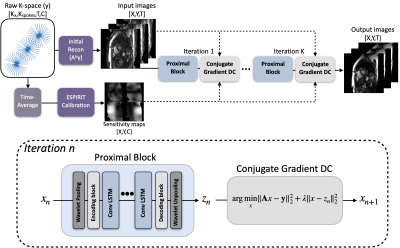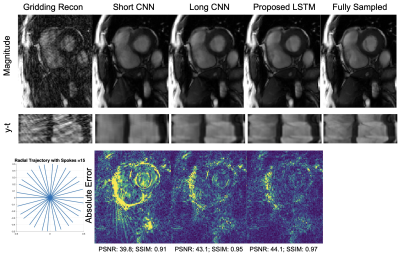Kanghyun Ryu1, Christopher M. Sandino1, Zhitao Li1, Xucheng Zhu2, Andrew Coristine3, Martin Janich4, and Shreyas S. Vasanawala1
1Stanford University, Stanford, CA, United States, 2GE Healthcare, Menlo Park, CA, United States, 3GE Healthcare, Montreal, QC, Canada, 4GE Healthcare, Munich, Germany
1Stanford University, Stanford, CA, United States, 2GE Healthcare, Menlo Park, CA, United States, 3GE Healthcare, Montreal, QC, Canada, 4GE Healthcare, Munich, Germany
We propose two methods to improve current UNN for Non-Cartesian cine cardiac image reconstruction. We use a memory efficient method for training to increase the number of unrolls. Also we use a novel network architecture based on Convolutional LSTM.

Figure 1. Overview of the MoDL-based UNN framework for radial CINE image reconstruction used in the study. Sensitivity maps are derived with ESPIRiT method, proximal block is designed with the proposed network architecture, data-consistency block (DC) is designed with conjugate gradient descent iterations.

Figure 3. Representative results of radial CINE reconstructions from synthetized images in short-axis view. The data was 18.8-fold accelerated with the trajectory shown in the bottom-left. The proposed method (number of unrolls=10, ConvLSTM) is compared to inverse gridding, Short CNN (number of unrolls=5, Conv2D+1D) and Long CNN (number of unrolls=10, Conv2D+1D). Proposed method provides improved reconstruction quality and sharper cardiac motion in the y-t profile image.
